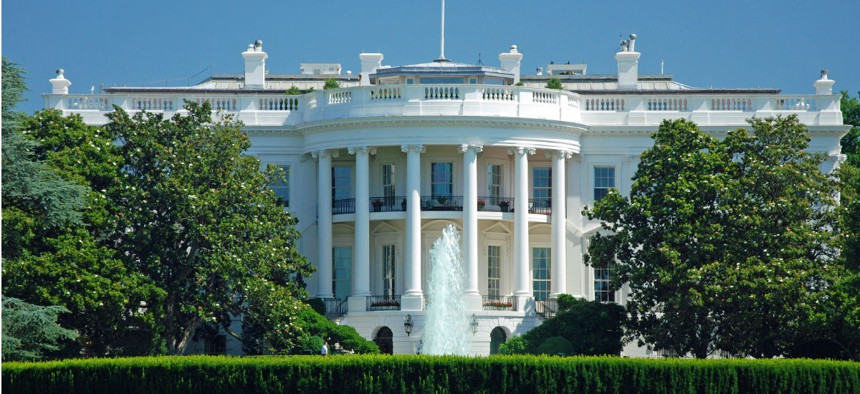White House Taps Techies to Apply Federal Data to Beating Poverty
Private software developers attend first demo of Opportunity Project.
In a melding of 21st century digital tools with neighborhood-level reach, the White House on Monday rolled out its public-private Opportunity Project, designed to inject thousands of federal data sets into the kind of local anti-poverty activism President Obama knew during his days as a Chicago community organizer.
Some 150 commercial and nonprofit software developers from 12 companies joined activists from eight cities for a White House demonstration of what Chief Data Scientist DJ Patil called “a fundamental game-changer.”
Accessed on the Census Bureau’s website, the Opportunity Project for the first time assembles a combination of federal and local data so that technologists, community groups and local governments “can help families find affordable housing, help businesses identify services they need, and help policymakers see inequities in their communities and make investments to expand fair housing and increase economic mobility,” a White House fact sheet said.
Examples demonstrated included interactive maps of available housing near public transit stops—a tool that would have been a godsend to the Baltimore single mother who described her exhausting eight-hour-a day commute to a dead-end job before local activists steered her to more workable arrangements and put her on a path to an accounting degree.
Software entrepreneurs combined existing data from the Census Bureau’s American Community Survey with data sets from the Housing and Urban Development and Commerce departments to map out housing, commuting, schools and shopping choices in formats friendly to non-techie citizens.
“Federal open data is much more meaningful when we do the compiling and curating ourselves,” said Aden Van Noppen, adviser to the chief technology officer at the White House Office of the Science and Technology Policy. “It’s more meaningful when there are partnerships, and intersections with life experiences in a community.” The packaged open data gives exposure to “voices not usually heard,” she added, “for neighborhood people who are experts in their own lives.”
Cecelia Munoz, director of the White House Domestic Policy Council, who set the project in motion two months ago, said, “The government has tremendous capacity to know what’s going on.” And using data to build capacity and grow the middle class “is the reason this president ran for office.” When the localized data-set project was launched, “I totally didn’t understand it,” Munoz added. “I am a policy nerd, a civil rights advocate.”
Megan Smith, the U.S. Chief Technology Officer and former vice president at Google, told the “Launch Day” gathering it is “awesome when two ecosystems come together. Instead of making a new website, there are so many popular ones on which we can add features.” For inspiration, Smith credited Obama’s fine-grained election data strategies, NASA’s recent mission to Pluto and the federal weather data gathering apparatus, which “sits on top of a billion-dollar industry of weather that makes beautiful products” available in maps that help in traffic planning and disaster response. She called for “an all-hands spirit” to help all Americans “take their communities into their own hands.”
Census Director John Thompson hailed the Opportunity Project’s potential for “incalculable insights and richness,” noting that the federal government has released more than 200,000 open data sets since 2009. The longtime Census employee who left for the nonprofit sector and returned, also praised the Presidential Innovation Fellows program, members of which helped prepare the new project, as “one of the best things I’ve seen since I’ve been back in government.”
The project’s links to Obama’s larger domestic agenda were highlighted by Luke Tate, special assistant to the President for economic mobility at the Domestic Policy Council. “We are the most prosperous nation at the most prosperous time in history. Yet not all are sharing it because of residential and educational segregation,” he said, lauding the project’s uses in identifying where transit stops belong and drawing equitable school boundaries. “A child’s ZIP code should never limit her future,” Tate said. “It’s time to move from information to activity.”
Cities participating in the first phase of the Opportunity Project are Baltimore; Detroit; Kansas City, Mo.; New Orleans; New York; Philadelphia; San Francisco; and Washington, D.C. Commercial and nonprofit software developers, many of whom demonstrated their online tools at the Old Executive Office Building, include Redfin, Zillow, GreatSchools, PolicyLink and Streetwyze.
The primarily young attendees from around the country -- most wearing lapel stickers reading, “I want [blank] in my neighborhood” – are the project’s “inaugural team,” Van Noppen said. They were invited to take selfies with teammates for posting on Facebook and Twitter.
The project is expected to expand, with engineers organizing “coding boot camps” for local youth and agencies coming up with customized projects, such as the Agriculture Department’s plan to use data to help rural citizens determine whether they wish to remain in the area of their birth. Obama will tout the Opportunity Project at the South by Southwest festival in Austin this Friday.
One potential problem with open data was highlighted by Antwi Akom of the beta website Streetwyze, which maps out assets in communities. On a map of East Oakland, he said, a proliferation of purple dots seemed to indicate “an oasis of grocery stores,” when on closer inspection—through people on the ground using social media—many turned out to be liquor stores. “We need to look “beneath the regulatory reader,” he said.
Chief Data Scientist Patil said, "Technology is not radical or revolutionary unless it benefits every single person.” The expansion of useful data sets “is no longer a story of single data scientists” working alone, he said. “It’s different for different communities, so it takes someone sitting in that community” to realize the potential. He called for expanding the eight cities by factors of 10 and 100. “The local level is literally what will inspire the next level of building,” he said.
(Image via Vacclav / Shutterstock.com)
NEXT STORY: The Information Revolution’s Dark Turn




